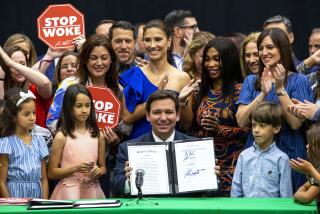The meaning of Brown vs. the Board
MOST AMERICANS recognize Brown vs. Board of Education as the 1954 decision that outlawed state-sanctioned segregation in public education. The decision inspired race-conscious government efforts in the 1960s and 1970s to integrate public schools and to bring racial minorities into the mainstream of American life.
But now, as the Supreme Court considers the constitutionality of race-conscious school integration plans in Louisville and Seattle, some say Brown stands for a different proposition. According to the U.S. government’s brief opposing the integration plans, Brown “held that intentionally classifying students on the basis of race violates the equal protection clause.” In oral arguments this month, this position won a sympathetic ear from Chief Justice John G. Roberts Jr., who likened the children in Seattle and Louisville to the children in Brown because “they’re being assigned on the basis of their race.”
To suggest, as some observers have, that Brown was ambiguous on whether government may be color-conscious or must be colorblind is engaging and provocative. But it is also wrong. Colorblindness may be defended in various ways, but a grounding in Brown vs. Board of Education is not one of them.
Nothing in the opinion establishes or suggests colorblindness as a legal principle, and for almost 30 years after Brown, the Supreme Court repeatedly said that using race to achieve school integration is consistent with Brown. The legal debate about colorblindness versus color-consciousness is a more recent phenomenon, fueled by cases in the last 20 years cutting back on government uses of race.
Brown was decided against the backdrop of Jim Crow, a state-enforced superstructure of racial hierarchy that was still in existence four score and six years after the 14th Amendment promised equal citizenship to all races. The unanimous court in Brown, led by Chief Justice Earl Warren, did not approach segregation as a legal abstraction. Instead, the court focused on the dignitary harm to black schoolchildren: “To separate them from others solely because of their race generates a feeling of inferiority as to their status in the community that may affect their hearts and minds in a way unlikely ever to be undone.”
Although Brown addressed public schools, the court quickly extended its holding to public parks, swimming pools, buses and golf courses. In this way, the court made clear that Brown applied to all aspects of the entrenched system of racial caste.
A decade after Brown, Congress passed landmark civil rights laws that effectively integrated the nation’s restaurants, motels and workplaces. In short, Brown’s principal legacy has been the dismantling of state-sanctioned racial apartheid in the United States.
Given this history, the idea that Brown prohibits “classification” by race is profoundly revisionist. Brown did not say that the mere use of race to assign students to schools was unconstitutional. As Roberts observed in his confirmation hearings, “the act of separating the students was where the violation was.” The target of Brown’s reasoning was not racial classification but the use of race to separate and thereby stigmatize and subordinate minority schoolchildren.
A unanimous 1971 decision by a Supreme Court composed of four Republican and five Democratic appointees confirmed that using race in student assignment was not itself the constitutional problem in Brown. School boards “might well conclude that in order to prepare students to live in a pluralistic society, each school should have a prescribed ratio of Negro to white students reflecting the proportion for the district as a whole,” Chief Justice Warren Burger wrote. “To do this as an educational policy is within the broad discretionary powers of school authorities.”
In 1982, the Supreme Court blocked a state ballot initiative preventing Seattle from voluntarily busing children to achieve integrated schools. Citing Brown, the court said that “attending an ethnically diverse school may help prepar[e] minority children for citizenship in our pluralistic society while teaching members of the racial majority to live in harmony and mutual respect with children of minority heritage.”
From 1954 to 1982, justices of all persuasions — from William Brennan to Lewis Powell to William Rehnquist — agreed that race-conscious integration policies stand in harmony, not tension, with Brown. Proponents of colorblindness contend that a strict rule against classifying by race has venerable roots in Justice John Marshall Harlan’s lone dissent in Plessy vs. Ferguson. Rejecting the “separate but equal” doctrine, Harlan famously wrote that “our Constitution is colorblind.”
But the court in Brown, while overruling Plessy, conspicuously omitted Harlan’s reference to colorblindness. In any event, Harlan’s words, read in context, show that he endorsed colorblindness as an antidote to racial hierarchy, not to mere color-consciousness: “[I]n view of the Constitution, in the eye of the law, there is in this country no superior, dominant, ruling class of citizens. There is no caste here. Our Constitution is colorblind, and neither knows nor tolerates classes among citizens.”
In a series of cases in the 1980s and 1990s, the Supreme Court began to change course, curtailing affirmative action in public contracting and higher education. A conservative majority of the court looked skeptically on race-conscious policies to remedy historic discrimination because they supposedly undermine merit-based selection. The question now is whether the court will extend this skepticism to race-conscious school assignment, a process that does not involve merit-based selection.
But let’s be clear. If the court decides to strike down the Seattle and Louisville plans, it will not have resolved any “ambiguity” in Brown. Brown unambiguously held that racial apartheid has no place in public schools or elsewhere in public life. The justices who decided Brown and their successors who enforced Brown saw no constitutional equivalence between race-conscious efforts to segregate and race-conscious efforts to integrate public schools.
A contrary holding would mark a novel application of colorblindness in contemporary doctrine — but a regrettable departure from the meaning of Brown.
More to Read
Start your day right
Sign up for Essential California for news, features and recommendations from the L.A. Times and beyond in your inbox six days a week.
You may occasionally receive promotional content from the Los Angeles Times.





